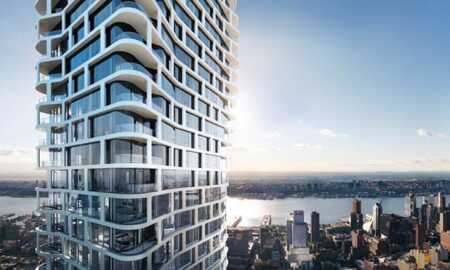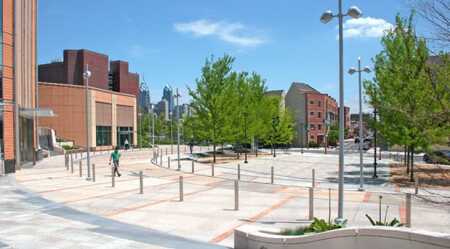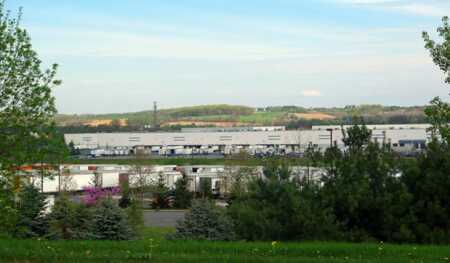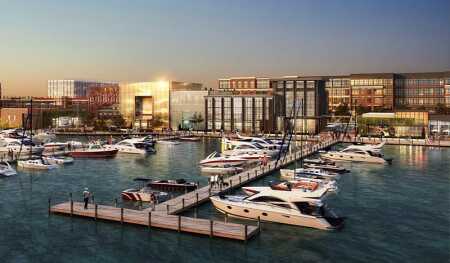Rising 1,079 feet (329 m) above Greenwich Street in New York City, the 2.5 million-square-foot (232,000 sq m) 3 World Trade Center (WTC) is the latest office building to open on the WTC site, providing unobstructed sight lines throughout its 80 floors as well as outdoor terraces on the 17th, 60th, and 76th floors.
More important, the $2.7 billion 3 World Trade Center—designed by Pritzker Architecture Prize–winning architect Richard Rogers and his firm, Rogers Stirk Harbour + Partners—offers some of the newest space in the metropolitan area. Rogers was also the recipient of the 2015 ULI J.C. Nichols Award. The building opened in June.
“New York City continues to grow and attract the world’s leading companies and we need new office space,” says Marty Burger, chief executive officer of Silverstein Properties, which developed the 3 World Trade Center tower. “If you look at other financial capitals of the world such as Hong Kong and London, 80 percent of their space is new. Here, only 7 percent of the city’s 400 million–plus square feet [37 million sq m] of space is new. To remain competitive, New York City needs to replace a lot of its aging buildings.”
New York is not alone. A number of cities in the U.S. Northeast are supplanting outdated office product with new thanks to strong, diversified economies; vigorous job creation; and increasing formation of businesses. Further driving development in the Northeast—New York, Massachusetts, Pennsylvania, and New Jersey—is continuing demand from the education and medicine (“eds and meds”) and technology sectors, among others.
“Existing downtown Class A buildings in cities like Boston and New York are aging,” says Revathi Greenwood, head of research for the Americas at Cushman & Wakefield. “Many do not have the conveniences required by today’s tenants. The focus on new construction and on-site amenities means many landlords are stepping up their game to attract tenants. Food halls, roof decks, communal space with giant TVs, and golf simulators are all perks that landlords are using to attract tenants.”
Philadelphia has experienced a tremendous amount of growth in recent years, particularly from a population standpoint, and expects to see continued solid performance in all development segments, especially multifamily, retail, and hospitality, says Paul J. Commito, senior vice president for development at Brandywine Realty Trust, a real estate investment trust headquartered in the city. “Philadelphia has always had a diversified economy; that has only broadened and deepened over the last few years,” he adds.
Boston’s real estate fundamentals provide for rapid growth in knowledge sectors as well as stability and innovation in more traditional education and professional services, says Carlos Febres-Mazzei, director in the Boston office of real estate investment banking company Eastdil Secured. “As long as we continue to support the growth in jobs and people, we will continue to be one of the most attractive real estate markets on the planet,” he continues. “We still have some work to do, including accessible and affordable housing, and modernization of our infrastructure. We are playing catch-up on these issues, but they appear to be at the forefront of our state and local agendas.”
New Jersey’s economy and real estate sector are improving, too. “There is near-term optimism from economic drivers including changes in the tax code and the promise of a loosening regulatory environment,” says Daniel Ligorner, vice president at privately held real estate firm Transwestern. “New Jersey Economic Development Authority incentives and a robust migrating talent pool continue to impact office development as developers and corporate executives look to optimize value associated with high-profile expansion, consolidation, and relocation.”
New York City
Fueled by tenants in the technology, advertising, media, and information systems (TAMI) fields, as well as a resurgence in the finance, insurance, and real estate (FIRE) industries, New York City’s office market remains one of the strongest in the Northeast. According to Cushman & Wakefield’s Greenwood, 30 percent of Manhattan’s leasing growth in the first quarter of 2018 was led by the financial services sector, which has recovered to pre–Great Recession levels driven by interest rate increases and financial deregulation. “TAMI is also a growth sector at 21 percent,” she adds.
“Facebook took approximately 250,000 square feet [23,000 sq m] at 770 Broadway in Manhattan, bringing its total footprint in that building up to 730,000 square feet [68,000 sq m]. Coworking is driving leasing activity as well at 21 percent.”

Above: Algin Management’s ARO—a new, 62-story residential tower in midtown Manhattan—features 426 luxury rental residences. Designed by CetraRuddy of New York, ARO has 40,000 square feet (3,700 sq m) of indoor and outdoor amenity spaces and 15,000 square feet (1,400 sq m) of retail space. It is expected to be finished later this year. (Binyan for IF STUDIO, courtesy Algin Management) Below: Cushman & Wakefield arranged $429.4 million of acquisition financing secured by 550 Washington Street in New York City.
In March, Google purchased the 1.2 million-square-foot (111,000 sq m) Chelsea Market located in and named after one of New York’s hippest neighborhoods. The Mountain View multinational technology company now owns two buildings in Manhattan, she notes, and if it expands Chelsea Market, Google could have up to 4.5 million square feet (418,000 sq m) in the city.

An 18-story, 270-foot (82 m) office tower, 412 W. 15, completed in 2018, is the tallest building in Manhattan’s trendy Meatpacking District. Together with an adapted historic building that connects to the new tower, Rockpoint Group’s 412 W. 15 offers 250,000 square feet (23,000 sq m) of commercial space and was designed by CetraRuddy. (David Sundberg/Esto, Courtesy CetraRuddy)
The 3 World Trade Center building, which is certified Gold under the Leadership in Energy and Environmental Design (LEED) rating system devised by the U.S. Green Building Council (USGBC), uses recycled rainwater in air conditioning and harnesses the energy derived from descending elevators. It also is attracting trendy, creative tenants, like global media investment management company GroupM, which leased 700,000 square feet (65,000 sq m), and management consulting firm McKinsey & Co., which signed up for 185,000 square feet (17,000 sq m). “Our leasing so far is going very well,” says Burger. “We are searching for a major tenant for 2 World Trade Center and will start construction as soon as we have one.”
A significant component of real estate value in the city derives from international investors. New York remains one of the top cities—if not the top city—in the world in which to invest, says Cushman & Wakefield vice chairman Steve A. Kohn, who is president of equity, debt, and structured finance at the firm. “Compared to other major global markets, New York offers an attractive combination of U.S. law and economic strength, a diverse market in terms of tenancy [financial services, tech, media, advertising, legal, life sciences], an exciting place to live, work, and play—a benefit to recruiting and retaining talent—and high cost and difficulty of developing new supply.”
Further stimulating international investment in America’s largest metropolis is readily available financing at virtually all levels. “Lenders value exposure in New York and pursue opportunities here accordingly,” Kohn says. “There are a significant number of opportunities to invest equity, either in acquisitions of properties, recapitalizations of existing partnerships, or funding new development. Equity investors would always like to see more offerings; however, many owners of attractive properties are not interested in parting with their assets.”
Boston
Boston’s real estate sector is benefiting from growth in technology, medicine, and education, says Maura G. Moffatt, managing director of investments at Boston’s Synergy Investments, a real estate investment and operating company focused on the local market.

The 40 Trinity Place/Raffles Boston/Back Bay Hotel & Residences development is a joint project of AccorHotels, the Saunders Hotel Group, and the Noannet Group. The 33-story hotel and condominium tower will contain 147 guest rooms and 146 residences. Construction is anticipated to begin later this year, with estimated completion in 2021.
Over the past decade, she adds, a number of nodes around Boston have transformed as a result of the growth of tech and the influx of knowledge workers to Boston, Cambridge, and the inner suburbs. “Boston’s historic downtown, formerly known as the Financial District and now simply called downtown, has morphed into the new Tech District,” Moffatt explains. “Boston’s Seaport, which includes the historic Fort Point Channel neighborhood—a brick-and-beam creative office mecca—and the new Innovation District, built on former mud flats and parking lots, have exploded, and a number of nodes spread throughout the inner suburbs have grown up or been reinvented as vibrant live/work/play urban environments as well.”
Among the major developments under construction, recently completed, or planned in the region is the Hub on Causeway by Delaware North and Boston Properties. The transit-oriented, 1.5 million-square-foot (139,000 sq m) mixed-use development is at TD Garden, the arena that is home to the Boston Bruins hockey team and the Boston Celtics basketball team. The first phase is expected to be completed later this year. (A detailed look at that project begins on page 110.)
Boston’s balanced and diversified economy has allowed the city to get a leg up on the real estate cycle, explains Eastdil’s Febres-Mazzei. “We were fortunate to get a bit of a head start coming out of the 2008 recession due to a formidable academic foundation, which drives tourism, population growth, and innovation,” he adds. “The millennial population has been coming of age in this cycle. In a market like Greater Boston, someone can find their first job, locate their first apartment, buy a condo, and start a new business. This micro-cycle drives several real estate product types: apartments, office, life sciences, for-sale housing, and coworking.”
Febres-Mazzei points out that in May, Amazon announced its move into 430,000 square feet (40,000 sq m) of space at WS Development’s 23-acre (9 ha) Seaport project, bringing 2,000 jobs in machine learning, speech science, cloud computing, and robotics engineering and doubling Amazon’s technology workforce in the metropolitan area. Amazon will occupy a 17-story mixed-use building designed by Gensler that is expected to begin construction later this year and be completed in 2021.

Boston design firm Dyer Brown updated the 271,000-square-foot (25,000 sq m) 116 Huntington Avenue in Boston’s historic Back Bay district for Columbia Property Trust in 2017. The update to the 15-story building included renovation of a two-floor penthouse office suite, with installation of two outdoor roof terraces. (©Chuck Choi, courtesy Dyer Brown)
Bringing Amazon to the Seaport is an excellent example of coordination across multiple political and private sector boundaries to attract thousands of high-paying jobs, he adds. “It was a great outcome for Boston,” says Febres-Mazzei. “Our academic institutions, real estate community, and local government have all been supportive. Certainly, we should continue to advocate for a continuous business-friendly environment with our policy makers—creating and expanding incentives for innovation and entrepreneurship, and helping to make real estate accessible, economical, and well supported by infrastructure.”
Still, transportation and housing affordability issues continue to vex the city, Moffatt says. “Addressing these problems is crucial to our continued growth and the health of Boston’s economy and derivatively the health of the real estate market,” she adds. “Rising construction costs are a major issue for all of the real estate in Boston and one of the key factors [but not the only factor] in the housing affordability problem and the challenges to creating more much-needed supply.”
Pennsylvania
Similar to Boston’s, Philadelphia’s eds-and-meds sector is performing exceptionally well and demonstrating innovative and proactive strategies for long-term growth on a national scale with services such as e-learning in education and personalized medicine initiatives in health care. “In addition, technology companies such as biotech’s young prodigy Spark Therapeutics and fintech [financial technology] software firm Amino—not to mention global telecommunications conglomerate Comcast—are proof positive of Philadelphia’s ability to create an environment that both fosters new emerging technologies and supports existing leaders,” says Commito.

The first phase of Brandywine Realty Trust’s mixed-use, master-planned community Schuylkill Yards is underway in the University City area of Philadelphia with the creation of Drexel Square, a 1.3-acre (0.5 ha) public green space that will feature an elliptical lawn and redwood trees, and the revamp of the iconic Bulletin Building, now known as One Drexel Plaza, designed by George Howe. (SHoP Architects; Brandywine Realty Trust)
That, in turn, is fueling real estate development such as Schuylkill Yards, Brandywine Realty Trust’s mixed-use master-planned community underway in the University City area of Philadelphia. “It will be one of the few places in the country with access to a large base of qualified talent, proximity to rail transit, and a robust set of amenities,” Commito says. “The first phase of the project includes the creation of Drexel Square, a 1.3-acre [0.5 ha] public green space that will feature an elliptical lawn and [dawn] redwood trees, and the revamp of the iconic Bulletin Building designed by George Howe.”
Large-scale developments such as the $1.5 billion, 60-story, 1,121-foot (342 m) Comcast Technology Center developed by Liberty Property Trust demonstrate the continued investment in Philadelphia. “So does our investment in quality of life,” Commito says. “Projects like Spruce Street Harbor Park and the Rail Park, as well as Drexel Square and Cira Green, accentuate the importance placed in the Philadelphia region on highly engaging public outdoor spaces.”

New York design firm Cooper Robertson worked with the Children’s Hospital of Philadelphia (CHOP) to plan and design a new 8.5-acre (3.4 ha) riverfront clinical research campus across the Schuylkill River in Philadelphia. Completed in 2017, the master plan provides a flexible phasing framework for long-term development of up to 2 million square feet (186,000 sq m) of clinical research uses. The first building for the campus is the Roberts Center for Pediatric Research, with 466,000 square feet (43,000 sq m) of clinical research and office space, designed by Ballinger and Pelli Clarke Pelli. (©2018 Frank Garnier, Ground Reconsidered)
Expansion and a strong economy are not limited to Philadelphia. The nearby Lehigh Valley, which includes Allentown, Bethlehem, and Easton, remains one of the fastest-growing logistics centers in the county with almost 100 percent employment.
“Manufacturing is the largest employment sector in Lehigh Valley,” says Becky A. Bradley, executive director of the Lehigh Valley Planning Commission in Allentown. “Our location is unmatched. We are close to ports of New York and New Jersey. With the expansion of the Panama Canal and the raising of the Verrazano-Narrows Bridge, the ports are expected to handle even more cargo in the years ahead. Interstate 78 is a straight shot into the Lehigh Valley to our transportation switching stations for air and rail. FedEx Ground is completing an 800,000-square-foot [74,000 sq m] terminal adjacent to the Lehigh Valley International Airport this year that will be the company’s largest warehouse and logistics hub among the 34 it operates nationwide.”

Nestlé Waters completed a two-year, $79 million expansion of its facility in Pennsylvania’s Lehigh Valley in 2017. Companies such as Nestlé are attracted by the valley’s central location, well-developed transportation network, strong workforce, and water and sewer infrastructure. (Lehigh Valley Planning Commission)
Since 2013, the Lehigh Valley has seen nearly 20 million square feet (1.9 million sq m) of industrial development, and more than 12 million square feet (1.1 million sq m) have been proposed, she adds.
“Allentown is the third-largest city in Pennsylvania and one of the youngest [in terms of population] in the state,” she adds. “The whole downtown has been transformed within the past three years. We’re having an amazing renaissance. But the Lehigh Valley didn’t lose industries because we were never part of the Rust Belt. We were always linked to Philadelphia and New York because of our easy access, whether it was canals, roads, rails, or air.”
New Jersey
Location also is a prime impetus for new real estate projects in New Jersey. Transwestern’s Ligorner notes that areas close to New York City such as Hoboken are reporting increased development. As part of the thriving Hudson River waterfront, one of the hottest destinations in the nation, Hoboken’s office market is nearly at full occupancy, he adds.

New York design firm Cooper Robertson’s master plan for Riverton, considered the largest mixed-use development in New Jersey history, transforms a 418-acre (170 ha) former brownfield and activates over three miles (5 km) of waterfront. The $2.5 billion project of Cincinnati-based North American Properties will offer 2,000 residential units; at least 1 million square feet (93,000 sq m) of office space; a variety of retail, entertainment, and hotel spaces; and a marina on the Raritan River. The development, now under construction, is expected to be completed in 2021. (Wakefield Beasley Associate)
Among the projects under construction is 1000 Maxwell Lane, a speculative mixed-use building with ground-level retail uses, 110,000 square feet (11,600 sq m) of office space, and luxury residential condominiums that are part of Maxwell Place, a joint venture of Pinnacle Companies and Toll Brothers City Living. Ligorner says that “1000 Maxwell Lane is the first speculative office project in the current market cycle. It is an opportunity to meet pent-up demand from the growing number of new innovators and existing TAMI companies on the New Jersey waterfront. As technology continues to change the way both developers and companies operate, and qualified workers continue to migrate toward transit-oriented, more affordable secondary and tertiary cities, build-to-suit and redevelopment projects are on the rise.”
Farther south in New Jersey, Prism Capital Partners is transforming a single-user, 116-acre (47 ha) complex that had gone dark into a multitenant, next-generation lifestyle hub called ON3. Spanning the border between Nutley Township and the city of Clifton, ON3 hopes to include a mix of residential, retail, office, and research and development (R&D) occupants, along with potential lodging and entertainment, says Eugene R. Diaz, principal partner of Prism Capital Partners based in Bloomfield, New Jersey.
The buildout of the former Hoffmann-LaRoche campus—nine miles (15 km) from the Lincoln Tunnel (into Manhattan)—will take several years, Diaz says. Prism envisions a “walking urbanism” concept integrating office and R&D facilities, recreational, hospitality, and wellness options.
“We believe projects like ours will be successful because New Jersey’s aging and poorly built historical office component is driving companies to seek out higher-quality offices in more proximate, pedestrian-friendly environments,” Diaz says. “More than 50 percent of New Jersey’s 175 million-square-foot [16.3 million sq m] office market was built between 1980 and 1992. With 35- to 40-year-old suburban product, you have floor size problems, ceiling height constraints, and other issues. That’s driving a lot of new office [development] and redevelopment.”
Even before Prism purchased the campus in October 2016, he says, Hackensack Meridian Health and Seton Hall University committed to leasing two major buildings totaling 477,000 square feet (44,000 sq m) and 16 acres (6.5 ha) on the campus.
Diaz adds that Prism could build a total of 4 million square feet (372,000 sq m) on the site but is taking time to master-plan the project. “With ON3, we’re creating the next-gen work, play, and live environment that corporations and individuals want to be around,” he adds.
New Jersey still needs to address its crumbling infrastructure to enable more growth and development, Diaz notes. “We have tunnel constraints and bridge problems, and we’re at capacity with NJ Transit, so infrastructure improvements are critical,” he adds.
Over the next few years, New York, Massachusetts, and Pennsylvania also must address crucial challenges ranging from rising construction costs to a dwindling supply of talent not only in the real estate and construction fields but also overall.
“Construction costs are rising rapidly, partly due to labor shortages, which raises the cost of ownership,” says C&W’s Greenwood. “There is clearly a shortage of workers. Here’s how bad it has become: In May, the national unemployment rate was 3.8 percent, or 6 million people. Based on the numbers, there are fewer unemployed people than there are job openings. If every unemployed person got a job, there would still be openings, but of course, the real issue is the skills mismatch.”










